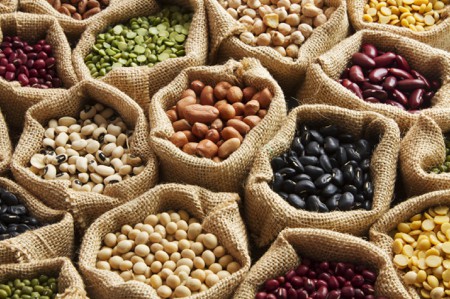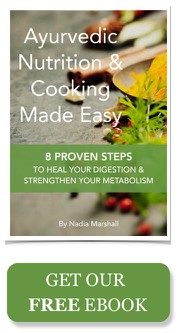By Nadia Marshall
Legumes have gotten a bad wrap of late because some of Australia's most popular food writers find them a bit bloaty or that too many of them 'muck with their guts'. Hard-core Paleo enthusiasts are avoiding them altogether because they believe the digestive system of humans hasn't adapted to consuming them.
This is debatable, but what is true is that legumes can indeed make you bloaty if you choose the wrong ones or don't prepare them correctly. My digestion is pretty sensitive and I'm rather tuned into it, so if a legume hasn't been prepared well, I feel it. Believe me. Having said that, I eat legumes every single day for at least one meal, usually two. How? With a little know-how. And now I'd like to share it with you.
Here are my top 5 tips for easily digesting legumes...
1) Choose Your Legumes Wisely
Not all legumes are created equal. Some are way more difficult to digest and gas-forming than others. The easiest to digest are split yellow mung daal, chilka mung daal (split but with the green skins still on) and split red lentils. You can eat these daily without a problem, especially yellow mung daal.
Ones that are moderately easy to digest include French puy lentils, toor daal, whole mung beans and adzuki beans. These are more of an occasional indulgence.
The more far more difficult to digest legumes are whole green, brown or red lentils, chickpeas, kidney beans and other beans like cannellini, pinto etc. I have these only every now and then.... and in my opinion, split peas should be avoided altogether (except in the depths of winter when Grandma has made a kick-ass pea and ham soup).
2) Prepare Your Legumes Well
Split mung daal, red lentils and puy lentils don't really need soaking but it doesn't hurt to give them a 30min-2 hr soak in cold water before cooking. Whole mung, adzuki beans, chickpeas, kidney beans and other beans need to be soaked overnight at a minimum.
The beauty of many legumes is that they can be dried and stored for very long periods of time. But this dry, astringent quality is also what makes them so gas-forming in the first place (it aggravates Vata). Soaking is an antidote to this quality and it also helps to reduce the anti-nutrients in these foods that can make them a little difficult to digest, namely phytic acid and lectins (lectins are the in-built pesticides of plants that can have a nasty effect on our internal bits while phytic acid binds to minerals like calcium, zinc and iron, making them less bioavailable (1)).
Cooking your legumes in a generous amount of good quality oil (e.g. ghee, olive oil etc) also helps to reduce their dry, astringent qualities.
3) Cook Your Legumes Thoroughly
Cook your split mung daal and red lentils until they lose their shape altogether and go creamy and smooth. This is way easier and faster in a pressure cooker - it takes 7 minutes instead of about 30. Pressure cooking is almost twice as effective at reducing anti-nutrients as normal cooking and is on-par with fermentation at reducing lectins (2). As for your whole legumes, cook them until they are super soft and easily squish between your fingers. Again, in a pressure-cooker is best.
Another way to reduce the gas-forming qualities of legumes is to scrape the foam off the top of the water when you first bring them to the boil. According to Chef Stephen Galpin (who used to manufacture chickpea-based food products for a living), this foam contains gas-forming enzymes so removing it makes your legumes even more gut friendly.
4) Always add Asafoetida. Always.
The most effective way to reduce the gas-forming qualities of legumes and to ensure they don't muck up your guts is to always, always, always cook them with asafoetida, also known as hing (even if the recipe doesn't tell you to). Asafoetida is a dried resin extracted from the root of the perennial herb, Ferula. Not only does asafoetida make legumes easier to digest, it also strengthens digestion generally and helps to treat bloating, flatulence, abdominal pain and belching (3).
Asafoetida usually comes in a powdered form cut with wheat or rice flour but you can occasionally get your hands on the pure resin (we sell an organic one at clinic). To use Asafoetida, add a pinch (1/8 tsp of pure, 1/4 tsp of powdered for two people) to the boiling water you are cooking your legumes in. You can also use it in place of garlic and onions if you are avoiding them for any reason - it imparts a similar flavour. One last thing.... you will need to store your asafoetida in a sealed glass jar or it will stink out your entire cupboard.
5) Always Eat Legumes Fresh. Always.
The final tip, and perhaps the most important of all, is to always, always, always eat your legumes FRESH, straight after cooking. Because I'm feeling generous and dislike waste, I'll say it is just okay to cook them for lunch and then re-heat the leftovers for dinner but if you do this, always add a little extra asafoetida when reheating and expect to get a little windy.
However, it really isn't so cool to cook legumes one day and then eat them the following day. This will definitely cause gas and bloating; no doubt about it. Sensitive tummies will really suffer from stale legumes. For the same reason, sensitive tummies will suffer from legumes from a can (because they are stale too) so as much as possible, cook your legumes from scratch. And.... try to avoid freezing your legumes. A thawed, re-heated legume dish will not be digestion-friendly. FRESH is best. But, if you do use legumes from a can, be prepared for a windy ride.... and just relax and enjoy it!
In Conclusion, Legumes Are Awesome.
In many ways, legumes are the perfect food they are: inexpensive, easy to transport, have a very long shelf-life, are environmentally-friendly, don't involve the killing large sentient beings and are super nutritious. And, when eaten with a grain or veggie (in the same day, doesn't even have to be the same meal - (4)), they provide a complete protein. Kitcharee, made from split mung daal and basmati rice with veggies on the side is an example of a perfect complete-protein meal.
Although legumes they are predominantly made up of carbohydrates, they are considered slow-carbs due to their high protein content. For example, google 'protein content beef' then 'protein content mung beans' and you'll see just a 2g difference between them (26g/100g vs 24g/100g). One is 'complete', the other 'incomplete' but it's still an interesting statistic...
From an Ayurvedic perspective, legumes are considered an Agni-friendly, light and easy way to digest protein and nourish the tissues compared to meat, eggs and dairy which are all very heavy. They are also considered relatively Sattvic (especially mung daal) which means they have a peace-creating effect on the mind. Meat, on the other hand, has a dulling or Tamasic effect on the mind.
So my friends, it is absolutely not necessary to avoid legumes, even if you have a sensitive tummy. In fact, well-cooked mung daal is considered a medicine for your digestion in Ayurveda and is also the one legume believed to actually reduce intestinal gas, if prepared correctly (5). All you have to do to make legumes easier to digest is choose them wisely, prepare them with love, antidote their qualities, cook them well, get your quantities right, eat them fresh and give any left overs to the dogs (with a sprinkle of fennel seeds on top to aid canine digestion and flatulence).
1 & 2) http://www.muditainstitute.com/blogs/happybelly/pressurecooking.html
3) "Traditional Principles of Ayurveda" by Sebastian Pole
4) http://lifespa.com/complete-protein-much-kind-eat/
5) http://lifespa.com/whats-so-amazing-about-khichadi/



